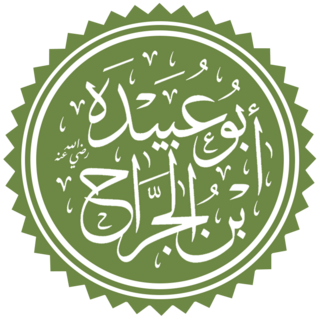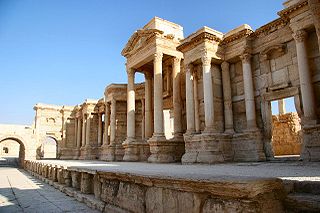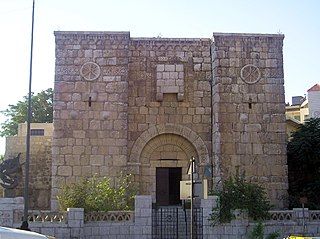Related Research Articles
The 630s decade ran from January 1, 630, to December 31, 639.

Year 634 (DCXXXIV) was a common year starting on Saturday of the Julian calendar. The denomination 634 for this year has been used since the early medieval period, when the Anno Domini calendar era became the prevalent method in Europe for naming years.

The Battle of the Yarmuk was a major battle between the army of the Byzantine Empire and the Muslim forces of the Rashidun Caliphate. The battle consisted of a series of engagements that lasted for six days in August 636, near the Yarmouk River, along what are now the borders of Syria–Jordan and Syria–Israel, southeast of the Sea of Galilee. The result of the battle was a complete Muslim victory that ended Byzantine rule in Syria. The Battle of the Yarmuk is regarded as one of the most decisive battles in military history, and it marked the first great wave of early Muslim conquests after the death of the Islamic prophet Muhammad, heralding the rapid advance of Islam into the then-Christian Levant.

ʿĀmir ibn ʿAbd Allah ibn al-Jarrāḥ, better known as Abū ʿUbayda was a Muslim commander and one of the Companions of the Islamic prophet Muhammad. He is mostly known for being one of the ten to whom Paradise was promised. He remained commander of a large section of the Rashidun Army during the time of the Rashid Caliph Umar and was on the list of Umar's appointed successors to the Rashidun Caliphate.

The Battle of Ajnadayn was fought in July or August 634, in a location close to Beit Guvrin in present-day Israel; it was the first major pitched battle between the Byzantine (Roman) Empire and the army of the Arab Rashidun Caliphate. The result of the battle was a decisive Muslim victory. The details of this battle are mostly known through Muslim sources, such as the ninth-century historian al-Waqidi.

The Muslim conquest of the Levant, also known as the Arab conquest of the Levant, occurred in the first half of the 7th century. This was the conquest of the region known as the Levant or Shaam, later to become the Islamic Province of Bilad al-Sham, as part of the Islamic conquests. Arab Muslim forces had appeared on the southern borders even before the death of Muhammad in 632, resulting in the Battle of Mu'tah in 629, but the real conquest began in 634 under his successors, the Rashidun Caliphs Abu Bakr and Umar ibn Khattab, with Khalid ibn al-Walid as their most important military leader.

The Battle of Bosra was fought in 634 between the Rashidun Caliphate army and the Byzantine Empire for the possession of Bosra in Syria. The city, then capital of the vassal Ghassanid Kingdom, represented the Islamic forces' first significant capture. The siege lasted between June and July 634.
Yazid ibn Abi Sufyan ibn Harb ibn Umayya was a leading Arab Muslim commander in the conquest of Syria from 634 until his death in the plague of Amwas in 639. Following the capture of Damascus around 635, he was placed in command of the city and its military district. After the death of the overall Muslim commander of Syria, Abu Ubayda ibn al-Jarrah, in 639, he was appointed by Caliph Umar the governor of Damascus, Jordan and Palestine.

The Rashidun Caliphate was the first of the four major caliphates established after the death of the Islamic prophet Muhammad. It was ruled by the first four successive caliphs (successors) of Muhammad after his death in 632 CE. These caliphs are collectively known in Sunni Islam as the Rashidun, or "Rightly Guided" caliphs. This term is not used in Shia Islam, as Shia Muslims do not consider the rule of the first three caliphs legitimate.

The Battle of Fahl, also known as the Battle of the Marshes and the Battle of Beisan, was a major battle in the Muslim conquest of Byzantine Syria fought by the Arab troops of the nascent Islamic caliphate and Byzantine forces at or near Pella (Fahl) and nearby Scythopolis (Beisan), both in the Jordan Valley, in December 634 or January 635.

The siege of Damascus (634) lasted from 21 August to 19 September 634 before the city fell to the Rashidun Caliphate. Damascus was the first major city of the Eastern Roman Empire to fall in the Muslim conquest of Syria.

The siege of Jerusalem (636–637) was part of the Muslim conquest of the Levant and the result of the military efforts of the Rashidun Caliphate against the Byzantine Empire in the year 636–637/38. It began when the Rashidun army, under the command of Abu Ubaidah, besieged Jerusalem beginning in November 636. After six months, the Patriarch Sophronius agreed to surrender, on condition that he submit only to the Caliph. According to tradition, in 637 or 638, Caliph Umar traveled to Jerusalem in person to receive the submission of the city. The Patriarch thus surrendered to him.

The siege of Emesa was laid by the forces of Rashidun Caliphate from December 635 up until March 636. This led to the Islamic conquest of Emesa, which was a major trading city of the Byzantine Empire in the Levant.
Battle of Marj-ud-Debaj was fought between the Byzantine army, survivors from the conquest of Damascus, and the Rashidun Caliphate army in September 634. It was a successful raid after three days of armistice, on the Byzantine survivors of the conquest of Damascus.

The Battle of al-Qadisiyyah, also spelled Qadisiyah, Qadisiyya, Ghadesiyeh or Kadisiya, fought in 636, was a decisive battle between the Arab Muslim army and the army of the Sasanian Empire of Persia during the first period of Muslim conquests.
Khalid ibn al-Walid ibn al-Mughira al-Makhzumi was an Arab Muslim commander in the service of the Islamic prophet Muhammad and the Rashidun caliphs Abu Bakr and Umar. He played the leading military role in the Ridda wars against rebel tribes in Arabia in 632–633, the initial campaigns in Sasanian Iraq in 633–634 and the conquest of Byzantine Syria in 634–638.
Khawla bint al-Azwar was an Arab Muslim warrior in the service of the Rashidun Caliphate. She played a major role in the Muslim conquest of the Levant, and fought alongside his brother Dhiraar. She is described as one of the greatest female soldiers in history. She was a companion of the Islamic Prophet Muhammad. She was once compared to Khalid Bin Walid by opponents on the battlefield.
The Battle of Sanita-al-Uqab was fought in 634 between forces of the Rashidun Caliphate led by Khalid ibn al-Walid against a Byzantine force sent by Byzantine Emperor Heraclius to relieve the besieged garrison of Damascus. Leading up to the battle, the Caliphate forces had intended to isolate the city of Damascus from the rest of the region; Khalid placed detachments in the south on the road to Palestine and in the north on the Damascus-Emesa route, and several other smaller detachments on routes towards Damascus. These detachments were to act as scouts and as delaying forces against Byzantine reinforcements. Heraclius's reinforcements were intercepted, and though they initially gained the upper hand, were routed at the al Uqab (Eagle) Pass when Khalid personally arrived with reinforcements.
The Battle of Marj al-Saffar took place in 634. At Damascus, Thomas, son-in-law of Byzantine Emperor Heraclius, was in charge. Receiving the intelligence of Khalid's march towards Damascus he prepared the defences of Damascus. He wrote to Emperor Heraclius for reinforcement, who was at Emesa that time. Moreover, Thomas, in order to get more time to prepare for a siege, sent the armies to delay, or if possible, halt Khalid's march to Damascus. One such army was defeated at the Battle of Yaqusa in mid-August 634 near Lake Tiberias 150 km from Damascus, another army that halted the Muslim advance to Damascus was defeated in the Battle of Marj al-Saffar on 19 August 634. It is said that Umm Hakim, a Muslim heroine was involved in this battle and killed seven Byzantine soldiers.
The Battle of Marj ar-Rum(Meadow of Rome), or also known as Battle of Marj Dimashq(Meadow of Damascus) was a conflict between Rashidun caliphate against Byzantine Empire occurred shortly after the Battle of Fahl in Byzantine attempt to recapture Damascus. Heraclius sent two separate forces which led by Theodore the Patricius and Shannash al-Rome respectively. The Rashidun army was led by Abu Ubaydah ibn al Jarrah and Khalid ibn al-Walid in order to assist Yazid ibn Abi Sufyan who act as garrison commander of Damascus.